I never wanted to ride elephants in Thailand, or anywhere else. Something about riding elephants never appealed to me. I’m not entirely sure the reason, but at least part of it was illustrations I remember of the Punic Wars from when Rome defeated Carthage.
Carthage was famous for its use of war elephants, and Rome managed to defeat them by basically tormenting them to death through the use of hooks, horns, and caltrops.
The Sad Story of the Asian Elephant
As an endangered species, Asian elephants are fighting for their long-term survival. Experts believe there are now only around 3,000 – 3,700 wild elephants living in Thailand. This is less than the number of captive elephants that can be found there.
The population is also declining at a rapid rate due to the loss of habitat in a growing country.
Elephant “taming” has been practiced in Southeast Asia for hundreds of years, with their primary use being in logging and the military. Now, however, thanks to the boom of tourism, things have gotten worse.
Where there is money, you better believe that there will be someone with questionable morals who is looking to make it.
These days, most captive elephants in Thailand are used as entertainment for tourists. It’s not that one reason is better than the other… logging or tourism, it’s just more of the bad.
Regrettably, most tourists are completely unaware of what it takes for them to be able to ride elephants. The suffering that they’re supporting.
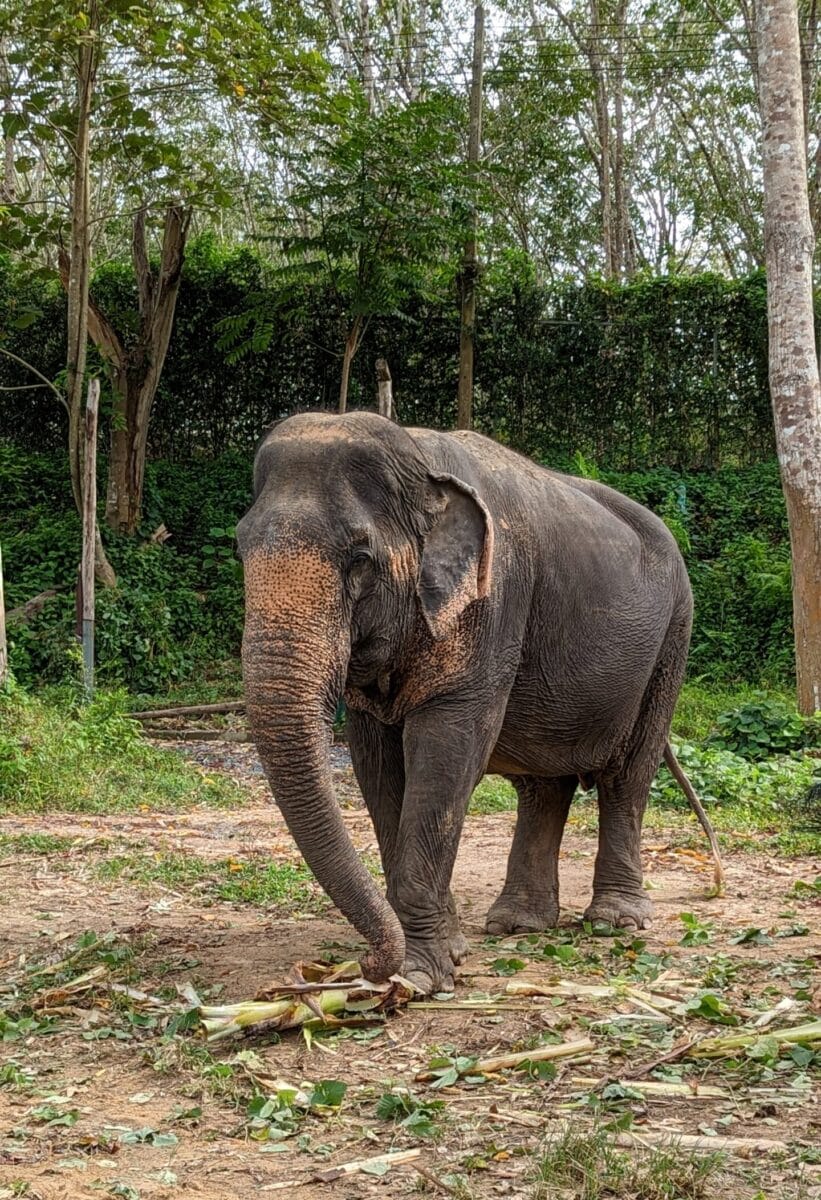
The Crush
Elephants are extremely smart, and they don’t want people riding them. The only reason they accept anyone on their back is that they’re terrified of what will happen if they don’t. It’s like the saying goes, “An elephant never forgets.”
Have you seen Harry Potter and the Deathly Hallows? Remember the dragon from Gringotts and the clankers? Same concept.
It’s been trained to expect pain when it hears the noise.
-Griphook
In order to tame a wild elephant, it is tortured as a baby to completely break its spirit in a barbaric process that is so common that it has its own name: Phajaan, or “the crush”. Literally crushing its spirit.

An example of a bullhook. These tools serve ZERO function other than for the torture and control of elephants.
The Process
The process starts with taking the baby elephants away from their mothers. To say that elephants are extremely family-oriented is an understatement. In the wild, females tend to remain with their mothers for life.
Even after decades apart due to forced separation, they’re still able to recognize one another when reunited. So taking them from their families is traumatic enough on its own.
After they’re taken, they’re locked in a very small space, such as a cage or hole in the ground, sometimes bound, and once they can no longer move, they’re beaten into submission.
They’re beaten with clubs, ripped with sharp bullhooks, and starved while being denied sleep for days on end.
If you really want, you can find videos of the process, but I wouldn’t recommend it as they’re supposedly graphic, disturbing, and sad to see. I personally haven’t watched any, but just knowing what’s in them is enough. I love animals and the thought of a screaming baby elephant churns my stomach.
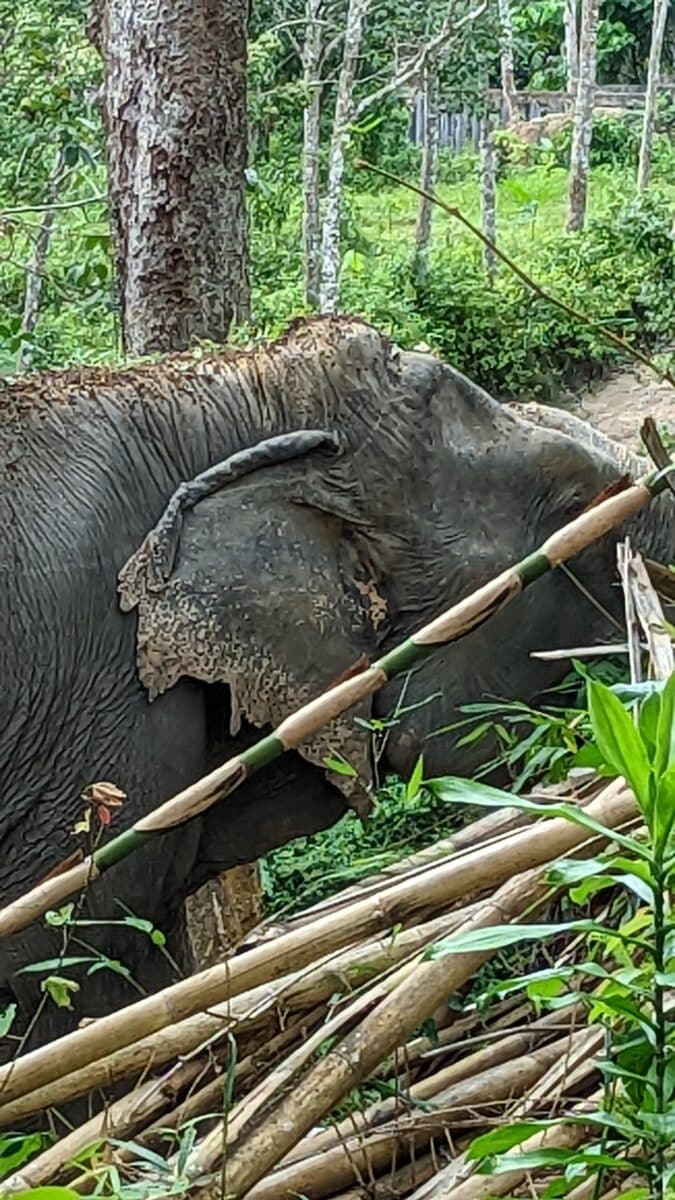
If seeing is believing… Next time you are near captive elephants, take a look at their ears which are one of the most common targets.
The Aftermath
The result is an animal that’s scared of its own shadow. They may appear happy, but it’s really just them being compliant out of nothing more than fear.
The signs of it are plainly obvious if you know what you’re looking at. Blind in one or both eyes, hair plucked from their tails and body, and the most telling, shredded ears.
The ears are a primary target for their tormentors. An elephant’s skin is super sensitive, and ripping apart their ears won’t maim them in the same way as shredding their legs.
Am I being overly descriptive? Too graphic? Well, some people need to hear it, because unfortunately, most tourists don’t even know that this is happening.
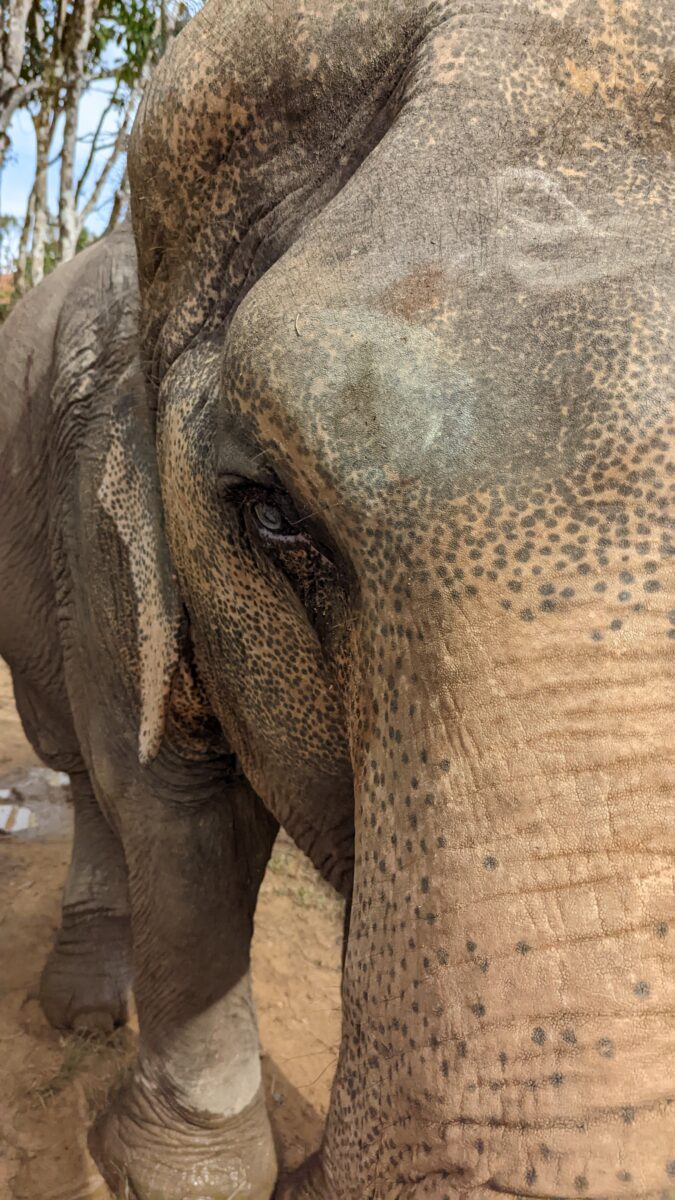
Notice the white coloring of her eye? It’s because she is blind due to her rough life in captivity. Imagine being this large and trying to walk around through a jungle without being able to see.
India
This isn’t just a Thai thing either. Wherever elephants are ridden, you WILL find their mistreatment. Perhaps you may have noticed that most U.S. circuses have stopped having elephants in their shows.
Upon writing this, I went back through my pictures from India to see how the elephants looked. Sure enough, there were a few missing chunks from some of their ears.
I was in India for Holi with a great group of people and had an amazing time there. It was one of my favorite trips of all time, but I must say, I was grossly disappointed that several of the others chose to ride elephants in one of the temples.
I was pretty vocal about why they shouldn’t ride elephants when it happened, both to the group and on my Instagram. At the time, you might have caught my story where I was railing against it. It was the most I’ve ever cursed in a story—”Don’t Fucking Ride Elephants.”
Did I change anyone’s mind about riding them? No, not that I’m aware of. Those who didn’t ride already knew about the dark side of the industry. The others, I guess just didn’t care, or like many, maybe they didn’t think it was really as bad as I said. Maybe they would have if I had gone into more graphic detail about the process, but back then, even though I knew, I still didn’t KNOW the full extent of the crush like I do now.
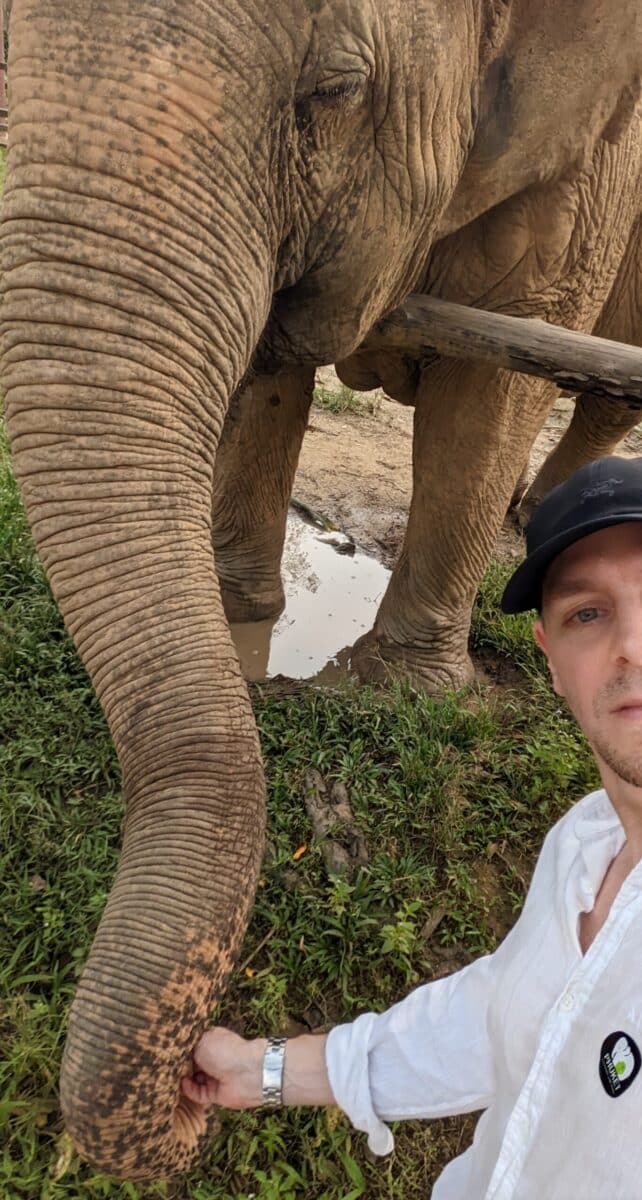
Boy don’t I look excited! I was actually really sick with a bad stomach bug while here. I had to crop out the side of my head because my eye looked crazy! o_X
Enter Elephant Sanctuaries
So what is an elephant sanctuary?
Elephant sanctuaries are theoretically where elephants go to live out the rest of their days in peace and quiet. The problem here is that there are many unethical “sanctuaries” that aren’t really sanctuaries at all. Sure, they may look it on the surface. Elephants frolicking in the grass, going for swims, eating fresh fruit….. and giving rides to unsuspecting tourists.
Can you ride an elephant there since it’s a sanctuary? No. If it’s advertised, or you see it happening, this isn’t just a red flag, it’s a full stop.
These faux sanctuaries and trekking camps may look friendly in front of the tourists, but you don’t know what’s going on while nobody is watching. A large part of their “happy-looking” elephants is a deep-rooted fear that keeps them in line.
Or, occasionally, you may see someone standing around with what looks like an old-fashioned walking cane. That’s a bullhook and its only use is hurting elephants.
It’s because of this that finding a truly ethical sanctuary is so important.

Phuket Elephant Sanctuary
Thankfully, many ethical elephant sanctuaries can be found. You may need to do a little research (though I have included a short list below), as even the fake ones advertise themselves as ethical, but a little Googling produces several versions of the same general list.
Phuket Elephant Sanctuary, where I went, focuses on rescuing older elephants with eye or leg injuries who spent their entire lives working in the logging and tourism industries. They do so well that they’ve been endorsed by both National Geographic and World Animal Protection International.
Founded in 2010, the Phuket Elephant Sanctuary is currently home to 13 elephants on a plot of 35 acres. While that may not sound like a lot when compared to a place like Elephant Nature Park, another ethical sanctuary, which is 250 acres, you need to consider the area. Things are a bit more crowded in Phuket when compared to northern Thailand.
Luckily though, PES is looking to expand in the near future, and you can help with that expansion through your tourism dollars, as well as donations.
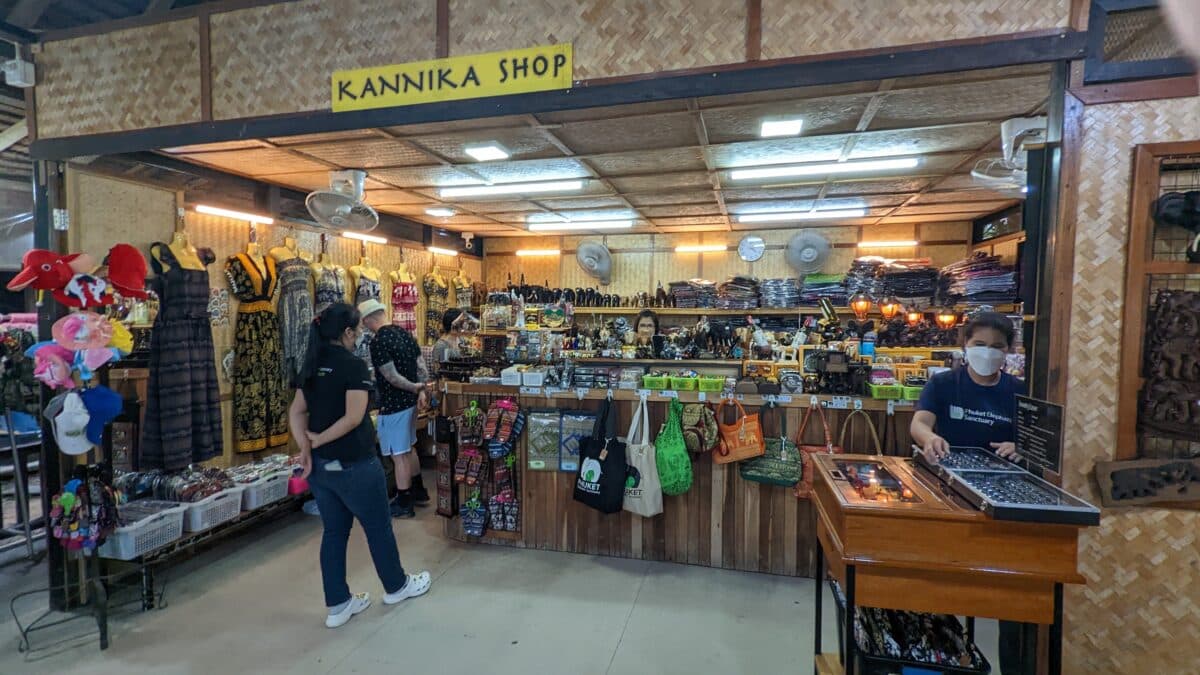
I try to not buy too many souvenirs while traveling as they really start to accumulate. I did, however, spend some money here because I knew it was going to a good cause.
The Experience
Phuket Elephant Sanctuary is set amongst two locations. First, you’ll pull up to the ticketing building on a main road where you give them your reservation. Be sure to register in advance because these experiences do sell out. When I went, I booked two days in advance and the morning was already full.
Both the morning and afternoon sessions are technically the same. I would have preferred the morning to try beating the heat. Thailand is hot and sticky.
The morning session is also ideal if you have any disabilities. There are wheelchairs for use on the canopy walkway, as well as electric golf carts, but most importantly, the elephants are fed their breakfast near the lodge so they’re easier to access.
After a brief wait, it was into the back of a covered truck for a bouncy ride into the jungle with about six others.
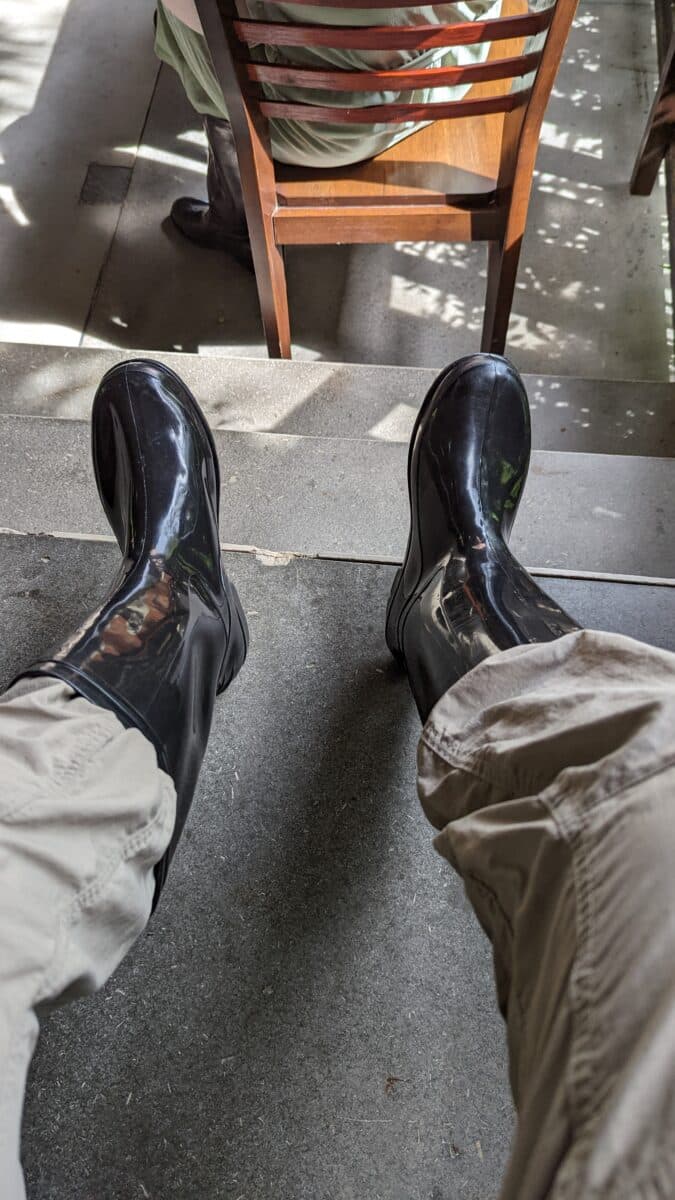
Suiting up in gum boots for a walk through the elephant sanctuary. While it was relatively dry during my trip, things can get very muddy with elephants stomping around.
Walking Among the Elephants
While I had seen pictures of people feeding elephants in Thailand and helping give them a bath, I wasn’t quite sure what to expect from a true sanctuary. Would I be able to feed them myself? What about petting? Since they were all rescues, maybe they would be skittish around humans.
After an initial orientation that outlined the history and plight of the Asian elephant as well as the sanctuary, everyone was divided into groups. These were determined by colored stickers that we were given.
I don’t know how groups are determined, but I think I lucked out as we were one of the smallest.
We got to meet some of the gentle giants right away.
Just outside of the lodge, one was taking a bath in what was called the hydro spa. We didn’t bother her while she was deep in the water, but it was fun to watch her trunk come up and seek out fresh fruit from the ledge.
After that, things got a bit rougher as we walked through the brush.
We started seeing elephants everywhere. One here, two there. It was great, especially seeing their meticulous process for how they take apart their food before eating it.
Those that were wandering were primarily eating various leaves. At one point, one of them wanted to change up her snack and decided to knock over fully-grown bamboo with little effort.
You already know that elephants are strong, but seeing just how strong firsthand is awesome. Even while on safaris where I’ve seen hundreds of elephants, I’ve never been able to get close enough for that.
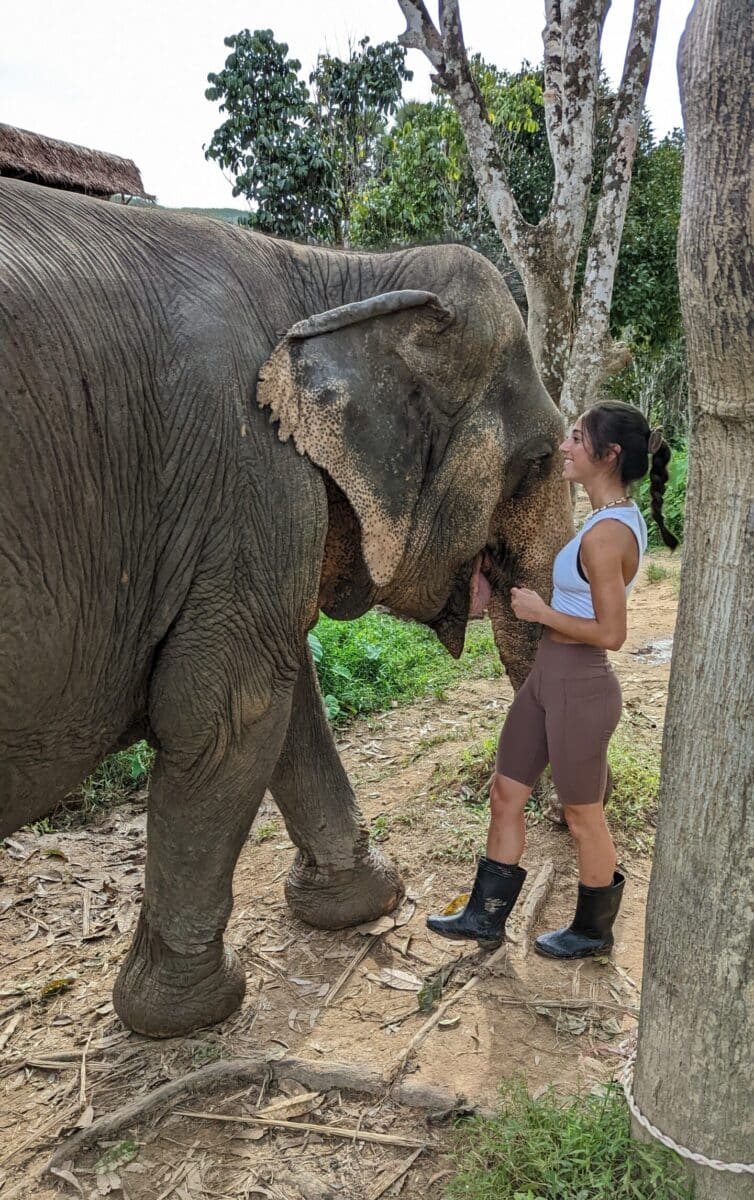
Should you wish, and if the elephant allows it, of course, you’ll be able to get up close and pet them. They’re quite friendly!
Elephants have hair!
You might not notice by looking at them, but elephants are a lot hairier than you would expect. Though some of these elephants now lack hair because it has been completely plucked.
Not to get down on all traditional ancient practices, but the Chinese black market is nothing but stupid morons. They use elephant hairs, especially from their tails, to make bracelets, rings, and earrings that they believe will protect them from illness or bring good luck. Some even take the tail completely.
Idiots.
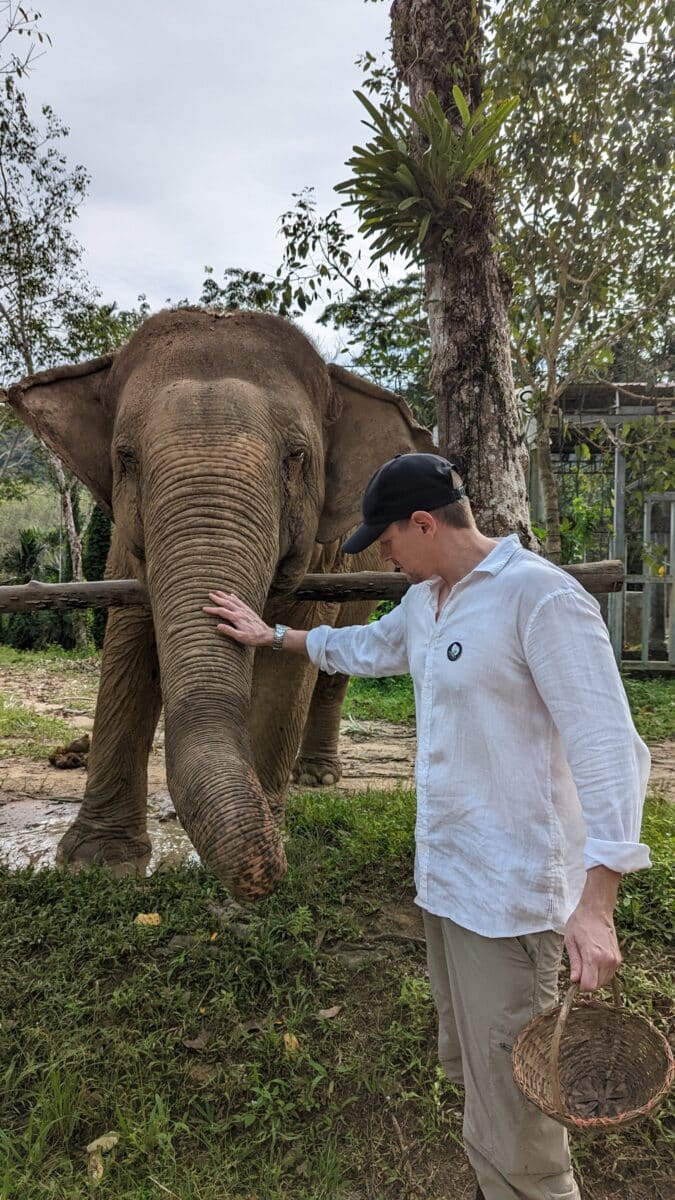
Their skin is hairy and rough. Definitely not what you’d expect!
Feeding time!
Over the course of the tour, we were given several opportunities to pet them, but feeding the elephants was the most fun.
For this, everyone lined up and was given a small basket of fruit. You could tell that the elephants were just as excited about this as we were!
Want to feed them again? They’ll be more than happy to let you! It was so much fun that I went back around four or five times!
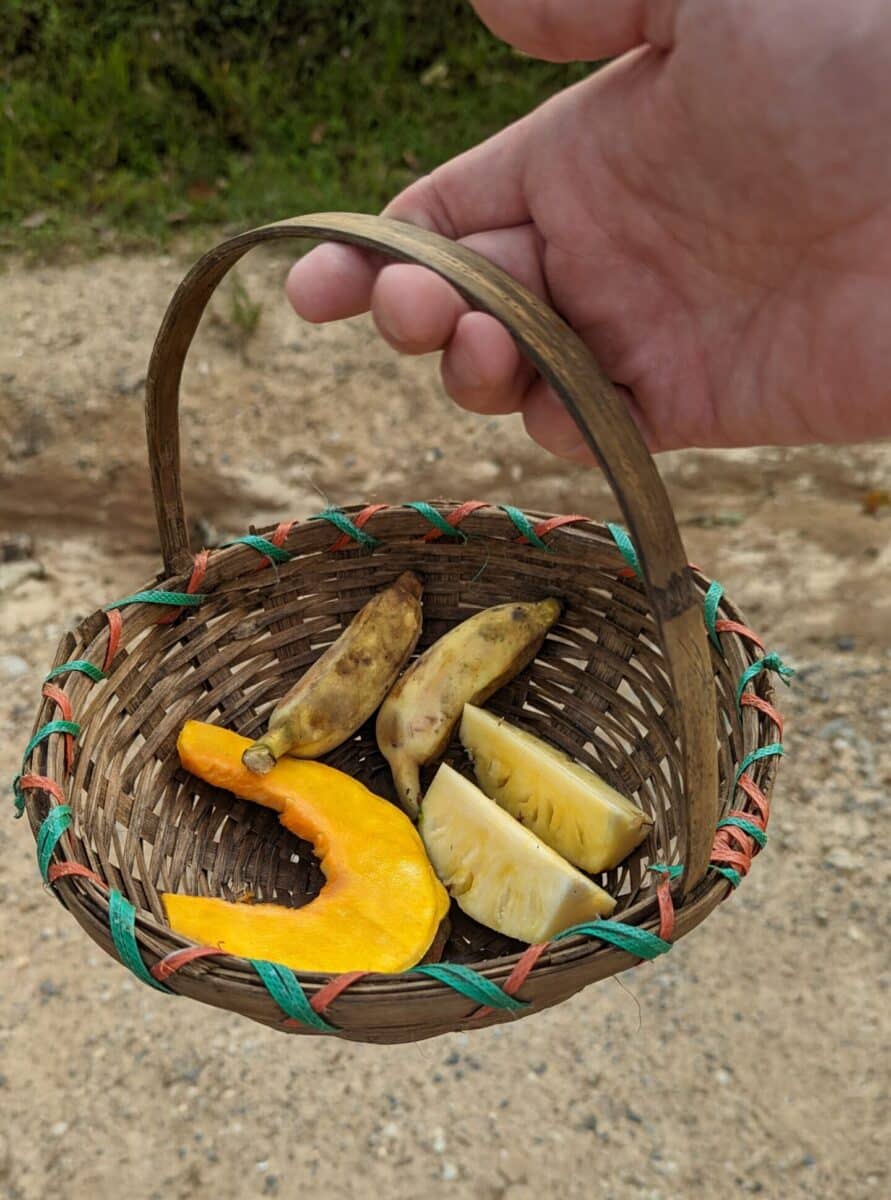
This may not look like much, but you’ll get to go back up. That’s because elephants eat between 330-375 pounds of food per day. That’s a lot of food!
Other Thailand Elephant Sanctuaries
Depending on where you are in Thailand, you may need to look around a bit to find a nearby sanctuary, but to help you out, here are a few that have been well-vetted:
Thailand:
- Phuket Elephant Sanctuary
- ChangChill
- Kindred Spirit Elephant Sanctuary
- Boon Lott’s Elephant Sanctuary
- Following Giants
- Global Vision International
- Elephant Nature Park
- Mahouts Elephant Foundation
- Somboon Legacy Foundation
- Burm and Emily’s Elephant Sanctuary
Remember, there are an estimated 3,800 elephants in captivity in Thailand. While sanctuaries may be included in that number, there is no way anywhere near that amount is living at the ten places on this list.
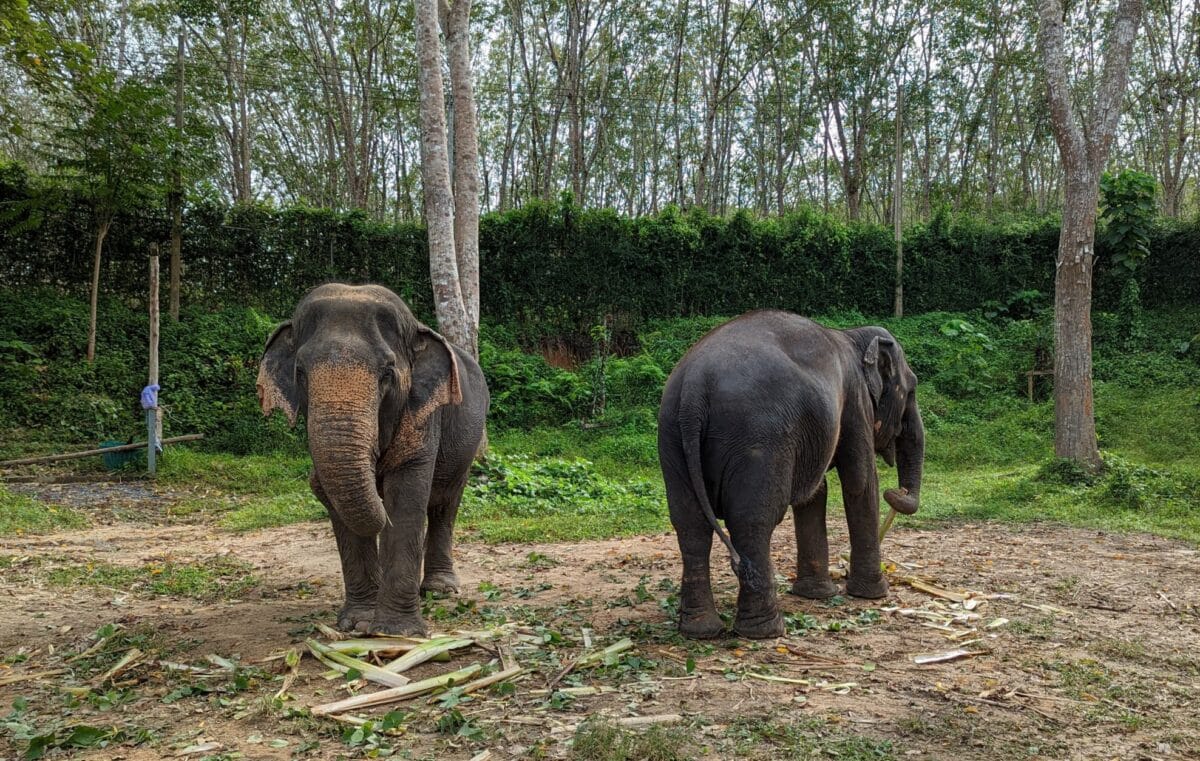
Sorry if these pictures are lacking a bit. As I mentioned, I had a pretty bad stomach bug. I was so out of sorts that I completely forgot my camera!
It’s up to you!
Ultimately, it’s up to you if you want to ride elephants in Thailand, India, South Africa, or wherever…
I can only preach about the brutalities of the practice so much. In the end, it will be your call if the torture of a baby elephant is worth your two minutes of riding on its back.
As such, I really do hope that this has helped to open the eyes of those who already have or may ride elephants in Thailand so that they can now make an informed decision.
As I said, most people who participate in elephant tourism in Thailand are completely unaware of how these gentle giants are treated.

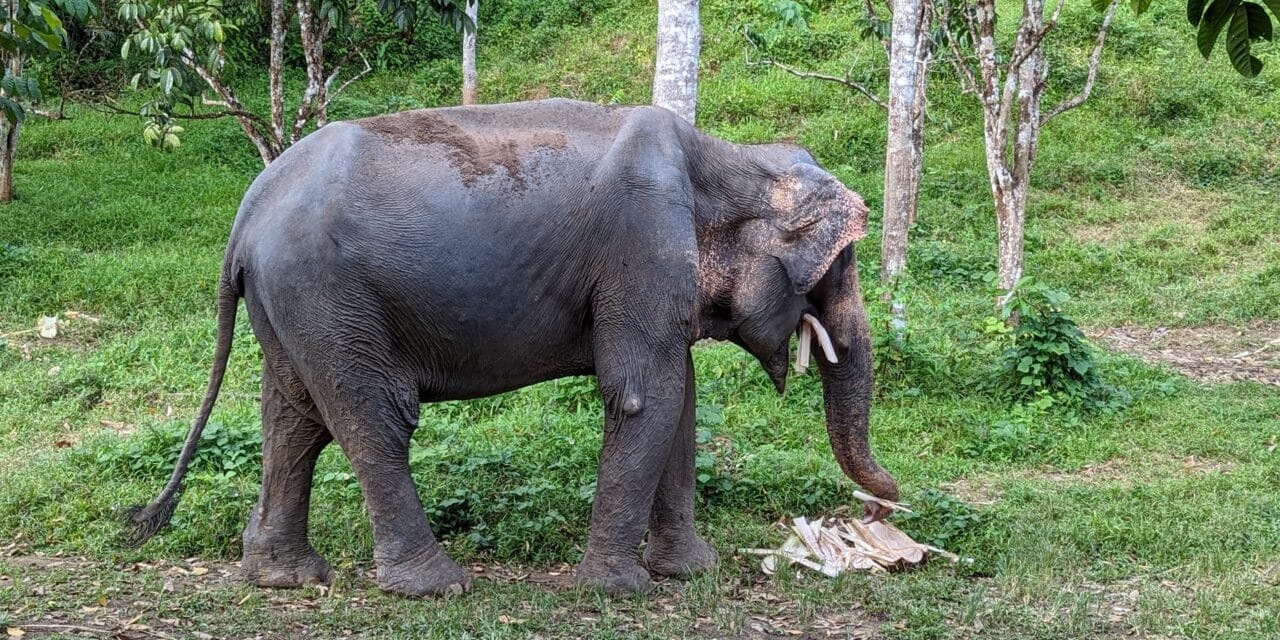





[…] on getting sick in Thailand and I almost quit on this trip in favor of a random […]